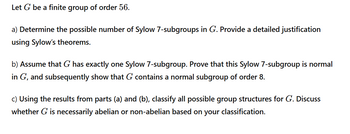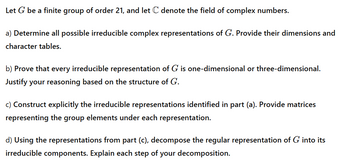
Elements Of Modern Algebra
8th Edition
ISBN: 9781285463230
Author: Gilbert, Linda, Jimmie
Publisher: Cengage Learning,
expand_more
expand_more
format_list_bulleted
Question
All parts fast

Transcribed Image Text:Let G be a finite group of order 56.
a) Determine the possible number of Sylow 7-subgroups in G. Provide a detailed justification
using Sylow's theorems.
b) Assume that G has exactly one Sylow 7-subgroup. Prove that this Sylow 7-subgroup is normal
in G, and subsequently show that G contains a normal subgroup of order 8.
c) Using the results from parts (a) and (b), classify all possible group structures for G. Discuss
whether G is necessarily abelian or non-abelian based on your classification.

Transcribed Image Text:Let G be a finite group of order 21, and let C denote the field of complex numbers.
a) Determine all possible irreducible complex representations of G. Provide their dimensions and
character tables.
b) Prove that every irreducible representation of G is one-dimensional or three-dimensional.
Justify your reasoning based on the structure of G.
c) Construct explicitly the irreducible representations identified in part (a). Provide matrices
representing the group elements under each representation.
d) Using the representations from part (c), decompose the regular representation of G into its
irreducible components. Explain each step of your decomposition.
Expert Solution
This question has been solved!
Explore an expertly crafted, step-by-step solution for a thorough understanding of key concepts.
Step by stepSolved in 2 steps with 7 images

Knowledge Booster
Similar questions
- Prove that the set of all complex numbers that have absolute value forms a group with respect to multiplication.arrow_forwardNeed detailed solutions to each parts as aparrow_forwardunder multiplication and let G be the group of all real 2x 2 matrices of -- Let G be the group of all non-zero complex numbers under multiplication and let G be the eroup of all real 2× 2 matrices of a b -b a the form where a and b are not both zero under matrix nlir plication. Show that G and G are isomorphic by exhibiting an isomorphism of G onto G.arrow_forward
- No without AI fast before 4:45arrow_forwardLet C* be the group of nonzero complex numbers under multiplica- tion and let H = {a+bi E C* | a² + b² = 1}. Give a geometric de- scription of the coset (3 + 4i)H. Give a geometric description of the coset (c+ di)H.arrow_forwardLet Zeven represent the set of even integers, {... -6, -4, -2, 0, 2, 4, 6, ...}. Determine if the system (Zeven, +): (i) is closed; (ii) is associative; (iii) has an identity element; (iv) has inverses; and (v) is commutative. Is (Zeven, +) a semi-group? Explain Is (Zeven, +) a group? Explainarrow_forward
- Let Zodd represent the set of odd integers, {... -5, -3, -1, 1, 3, 5, ...}. Determine if the system (Zodd, +): (i) is closed; (ii) is associative; (iii) has an identity element; (iv) has inverses; and (v) is commutative. Is (Zodd, +) a semi-group? Explain Is (Zodd, +) a group? Explainarrow_forwardProve that the set of all 2 x 2 matrices with entries from R and determinant+1 is a group under matrix multiplication.arrow_forwardShow that the mapping Φ(a + bi) = a - bi is an automorphism of the group of complex numbers under addition. Show that Φ preserves complex multiplication as well—that is, Φ(xy) = Φ(x)Φ(y)arrow_forward
- Show that O(n), the set of all orthogonal n × n matrices is a group under matrix multiplication.arrow_forwarda) Show that 0 = {( 96 ) ( ) ( ¯)} P {(9), C has an identity element with respect to matrix multiplication. b) Does each element of P have an inverse with respect to matrix multiplication? c) Is P a group with respect to matrix multiplication?arrow_forwardProve that the group of real numbers (with addition as the binary operation) is isomorphic to the group of positive real numbers with respect to multiplication.arrow_forward
arrow_back_ios
SEE MORE QUESTIONS
arrow_forward_ios
Recommended textbooks for you
 Elements Of Modern AlgebraAlgebraISBN:9781285463230Author:Gilbert, Linda, JimmiePublisher:Cengage Learning,
Elements Of Modern AlgebraAlgebraISBN:9781285463230Author:Gilbert, Linda, JimmiePublisher:Cengage Learning, Linear Algebra: A Modern IntroductionAlgebraISBN:9781285463247Author:David PoolePublisher:Cengage Learning
Linear Algebra: A Modern IntroductionAlgebraISBN:9781285463247Author:David PoolePublisher:Cengage Learning Elementary Linear Algebra (MindTap Course List)AlgebraISBN:9781305658004Author:Ron LarsonPublisher:Cengage Learning
Elementary Linear Algebra (MindTap Course List)AlgebraISBN:9781305658004Author:Ron LarsonPublisher:Cengage Learning

Elements Of Modern Algebra
Algebra
ISBN:9781285463230
Author:Gilbert, Linda, Jimmie
Publisher:Cengage Learning,

Linear Algebra: A Modern Introduction
Algebra
ISBN:9781285463247
Author:David Poole
Publisher:Cengage Learning

Elementary Linear Algebra (MindTap Course List)
Algebra
ISBN:9781305658004
Author:Ron Larson
Publisher:Cengage Learning